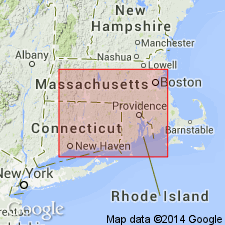
- Usage in publication:
-
- Shawsheen Gneiss*
- Modifications:
-
- Age modified
- AAPG geologic province:
-
- New England province
Summary:
Radiometric age determinations and correlative relations indicate that the Shawsheen Gneiss is Proterozoic Z or Ordovician. Age of informal schist in Hunts Brook in southeastern CT is considered to be same as for Tatnic Hill Formation in CT and MA. Tatnic Hill is almost certainly equivalent to upper part of Nashoba Formation of MA. Nashoba Formation is intruded by Andover Granite, dated as Late Ordovician to Early Silurian by Rb/Sr methods (R.E. Zartman, unpub. data, 1978). This indicates that Nashoba and Tatnic Hill are Ordovician or older. Foliated pegmatite in Tatnic Hill Formation has discordant Pb-Pb zircon age of 520 m.y. (Zartman and others, 1965), indicating a Cambrian or older age, but origin and history of zircons is uncertain. U-Pb concordia plots of a suite of zircons from below Nashoba Formation in eastern MA (Fish Brook Gneiss and Shawsheen Gneiss) give an age of about 742 m.y. (Olszewski, 1978), suggesting that Nashoba and Tatnic Hill could be Proterozoic Z; however, zircons from Middlesex Fells Volcanic Complex were probably included in the above-mentioned suite, according to Olszewski, so that the age is suspect. Age of Nashoba, Tatnic Hill, and schists in Hunts Brook is considered to be Proterozoic Z or Ordovician.
Source: GNU records (USGS DDS-6; Reston GNULEX).

- Usage in publication:
-
- Shawsheen Gneiss*
- Modifications:
-
- Overview
- AAPG geologic province:
-
- New England province
Summary:
Used as Shawsheen Gneiss of Proterozoic Z or Ordovician age.
Source: GNU records (USGS DDS-6; Reston GNULEX).

- Usage in publication:
-
- Shawsheen Gneiss*
- Modifications:
-
- Overview
- AAPG geologic province:
-
- New England province
Summary:
Shawsheen Gneiss consists primarily of sillimanitic muscovite-biotite schist and gneiss, and contains a few lenses of layered and massive amphibolite. Lithologically similar to much of Nashoba Formation. Was mapped as part of Nashoba by Hansen (1956); nor did he recognize rocks later called Fish Brook Gneiss by Castle (1965) as a mappable unit. Bell and Alvord (1976) separated Shawsheen from Nashoba because Fish Brook Gneiss intervened between Shawsheen and rest of Nashoba. However, Barosh and others (1977) included both the Shawsheen and Fish Brook in the Nashoba. Although Castle (1965) considered Fish Brook to be either a premetamorphic intrusive rock or a core gneiss of intrusive or sedimentary ancestry, Bell and Alvord (1976) considered it to be volcanic or volcaniclastic in origin. Zircons in Fish Brook are certainly volcanic in origin and yield a date of 730 +/-26 Ma (Olszewski, 1980). If the rock were a core gneiss, that date would apply only to the Fish Brook and not to surrounding rocks; but, Bell and Alvord (1976) believe Fish Brook to be part of the Marlboro Formation-Nashoba Formation sequence and therefore the date does apply to the sequence. In addition, a 1500 Ma date for Shawsheen Gneiss [reference not given] helps bracket age of Marlboro-Nashoba sequence. An upper limit for the sequence was established from the 430 +/-5 Ma age of intruding Sharpers Pond Diorite and 450 +/-23 Ma age of the intruding Andover Granite (Zartman and Naylor, 1984). Although age on MA State bedrock map is shown as Proterozoic Z or Ordovician (due to uncertainty regarding actual rocks sampled by Olszewski and a strong belief that rocks of Nashoba zone correlated with Ordovician rocks to the west), author now feels that rocks of Nashoba zone (except for Tadmuck Brook Schist) are all Proterozoic, but that they are unlike the Proterozoic rocks of neighboring Milford-Dedham zone. [No formal age change made in this report]. Report includes geologic maps, stratigraphic columns, and correlation charts. [Chapters A-J in U.S. Geological Survey Professional Paper 1366 are intended as explanations and (or) revisions to 1:250,000-scale MA State bedrock geologic map of Zen and others (1983).]
Source: GNU records (USGS DDS-6; Reston GNULEX).
For more information, please contact Nancy Stamm, Geologic Names Committee Secretary.
Asterisk (*) indicates published by U.S. Geological Survey authors.
"No current usage" (†) implies that a name has been abandoned or has fallen into disuse. Former usage and, if known, replacement name given in parentheses ( ).
Slash (/) indicates name conflicts with nomenclatural guidelines (CSN, 1933; ACSN, 1961, 1970; NACSN, 1983, 2005, 2021). May be explained within brackets ([ ]).

